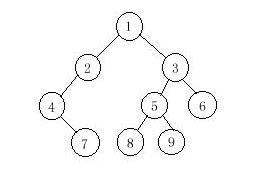Binary Tree Traversals
Problem Description
A binary tree is a finite set of vertices that is either empty or consists of a root r and two disjoint binary trees called the left and right subtrees. There are three most important ways in which the vertices of a binary tree can be systematically traversed
or ordered. They are preorder, inorder and postorder. Let T be a binary tree with root r and subtrees T1,T2.
In a preorder traversal of the vertices of T, we visit the root r followed by visiting the vertices of T1 in preorder, then the vertices of T2 in preorder.
In an inorder traversal of the vertices of T, we visit the vertices of T1 in inorder, then the root r, followed by the vertices of T2 in inorder.
In a postorder traversal of the vertices of T, we visit the vertices of T1 in postorder, then the vertices of T2 in postorder and finally we visit r.
Now you are given the preorder sequence and inorder sequence of a certain binary tree. Try to find out its postorder sequence.

In a preorder traversal of the vertices of T, we visit the root r followed by visiting the vertices of T1 in preorder, then the vertices of T2 in preorder.
In an inorder traversal of the vertices of T, we visit the vertices of T1 in inorder, then the root r, followed by the vertices of T2 in inorder.
In a postorder traversal of the vertices of T, we visit the vertices of T1 in postorder, then the vertices of T2 in postorder and finally we visit r.
Now you are given the preorder sequence and inorder sequence of a certain binary tree. Try to find out its postorder sequence.

Input
The input contains several test cases. The first line of each test case contains a single integer n (1<=n<=1000), the number of vertices of the binary tree. Followed by two lines, respectively indicating the preorder sequence and inorder sequence. You can assume
they are always correspond to a exclusive binary tree.
Output
For each test case print a single line specifying the corresponding postorder sequence.
Sample Input
9 1 2 4 7 3 5 8 9 6 4 7 2 1 8 5 9 3 6
Sample Output
7 4 2 8 9 5 6 3 1
题目的意思很清楚 , 就是给你两个限定长度的数字,然后分别是二叉树的 先序中序的顺序, 然后 需要输出后序;
#include<iostream> #include<cstring> #include<cstdlib> #include<string> using namespace std; int a[1010],b[1010]; struct Tree { Tree *l,*r; int x; }; Tree *root; Tree *jian(int *a,int *b,int n) //建树 { int i; Tree *ss; for(i=0;i<n;i++) { if(a[0]==b[i]) { ss=(Tree *)malloc(sizeof(Tree)); ss->x=b[i]; ss->l=jian(a+1,b,i); ss->r=jian(a+i+1,b+i+1,n-i-1); return ss; } } return NULL; } void bianli(Tree *h) { if(h!=NULL) { bianli(h->l); bianli(h->r); if(h==root) cout<<h->x; else cout<<h->x<<" "; } } int main() { int n,i; while(cin>>n&&n>0) { root=NULL; for(i=0;i<n;i++) { cin>>a[i]; } for(i=0;i<n;i++) { cin>>b[i]; } root=jian(a,b,n); Tree *h=root; bianli(h); cout<<endl; } return 0; }























 256
256

 被折叠的 条评论
为什么被折叠?
被折叠的 条评论
为什么被折叠?








